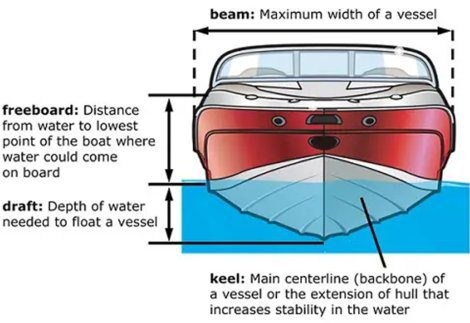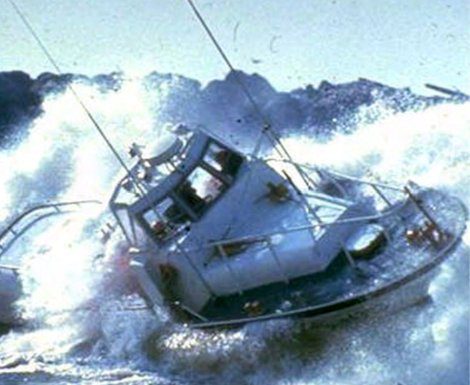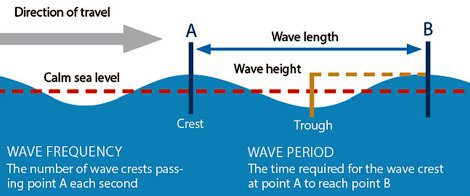 By Bob Currie, Recreational Boating Safety Specialist
By Bob Currie, Recreational Boating Safety Specialist
U. S. Coast Guard Auxiliary Station Galveston Flotilla
I monitor the Coast Guard rescues and analyze what went wrong in each case as much as I can with the limited information given for each incident. There is a common theme to most of the offshore rescues: the boat is taking on water and has either been swamped or is in danger of being swamped. Swamping is not something you can recover from when you are offshore. Another term for swamping is loss of freeboard. You are no longer afloat when you are fully swamped. There are several ways to get into this predicament, and those ways are the discussion for the day.

What is Freeboard?
Freeboard is the measurement from the waterline to the top of the sides of the boat at the lowest point where water can enter the boat. In contrast, a boat’s draft is the measurement from the waterline to the bottom of the hull and includes appendages such as rudders and propellers. Both measurements are relative to the total weight of the occupants and gear. The more weight you have, the less freeboard and more draft you have. You can adjust your freeboard by limiting your passenger numbers and weight and the total weight of your gear, including your engine. Don’t forget that engine weight. I once sold a boat I had to someone who removed the 50 hp engine (maximum allowed by the capacity plate) and he added a 90 hp engine. I saw him at the boat launch and saw how the stern really hunched down in the water. He had very little freeboard at the transom, and after a few weeks of running up and down the river I got word that he experienced zero freeboard and sank that boat in about 50 feet of water.

How Much Freeboard Do You Need?
The answer is simple, although finding that answer may be difficult: You should have enough freeboard such that your boat remains stable in extreme conditions. If your freeboard is too low, waves or swells could swamp or capsize your boat. Boats with low freeboard, such as bay fishing boats like mine, have low freeboard and shallow draft so we can fish the productive shallow waters. Such boats may be designed to handle light chop, but with a twelve inch freeboard we would have difficulty navigating in heavy chop and certainly couldn’t handle 1-2 foot seas very long.
Typical offshore recreational boats have high freeboard and can handle a certain amount of wind and wave action, but there is a point in which there is not enough freeboard to keep the boat from being swamped by large waves. It is up to you to determine if your boat can handle the sea state.
What is Sea State?
Everyone knows the power of water is great. It can cut through steel or fling a recreational boat through the air as if it were nothing. Mariners call the power of water the sea state, and a good working knowledge of sea states is necessary in order to survive on the open sea. Another term for sea state is waves, and that is what most people associate with the sea state, but there is much more to the sea state than waves. Here are a few terms and their definitions so that you will understand what we are talking about.

Terms
- Sea State: In oceanography, Sea state is the general condition of the surface of a large body of water- with respect to wind waves and swell- at a certain location and moment. Sea state is characterized by wave height, wave period, and power spectrum.
- Wave Height: Wave height is the difference between the wave crest (top of the wave) and the neighboring trough (bottom of the wave). Wave height is further broken down by most frequent waves, significant waves, and maximum waves.
- Most Frequent Waves: Most frequent waves are about half the height of significant waves. They represent about two thirds of the waves seen in a particular area and are about half the height of significant waves.
- Significant Waves: Significant waves are the highest third of the waves in a particular area. If you hear that the waves are “three to five feet,” that means the most frequent waves are three feet high, and the significant waves are five feet high.
- Maximum Waves: Maximum waves are usually twice the height of significant waves but are infrequently seen (average three times per 24-hour period). Those are the ones that sneak up on you. You might hear someone say the waves are “three to five feet, occasionally up to ten feet.” That is the range of waves from most frequent, to significant, to maximum waves.
- Wave Period: Wave period is the distance between two waves passing through a stationary point, measured in seconds. Another way to put it is wave period is the amount of time it takes for a wave crest to travel one wavelength.
- Wave Length: Wave length is the distance between two crests measured in feet. Shorter wave lengths also tend to be shorter in height.
- Ocean Swells: Ocean swells are ocean waves that move beyond the place where they were generated. Ocean swells can travel great distances and inevitably encounter other swells of different lengths and heights and traveling in different directions. A typical sea state is made up of a mixture of deep-water swells and waves, which all combine to form the chaotic ocean surface known as the wave spectrum.
- Wave Power Spectrum: The energy in waves comes from the movement of the ocean and the changing heights and speed of the swells. An average 4-foot wave striking the coast puts out more than 35,000 horsepower per mile of coast. Waves get their energy from the wind, and the wind comes from solar energy. As long as the sun shines, wave energy will never be depleted.
- Combined Seas: Wind waves are independent of the swell and add to the wave height. The result is called the combined seas. The National Weather Service considers the combined seas equal to the significant wave height.
How Do You Increase Freeboard?
The obvious time to adjust freeboard is before you leave the dock. The capacity plate gives you the recommended maximum weight and number of passengers, as well as the maximum outboard motor horsepower. Before leaving the dock you can reduce weight and thus increase freeboard. You can also adjust your trim by properly distributing the gear and passengers so that the boat sits well in the water rather than down in the bow or stern or leaning to one side. You can adjust the freeboard underway by adjusting your trim by raising or lowering your engine and by shifting passengers so their weight is evenly distributed. If there is heavy spray while underway, some passengers tend to move to the stern to stay out of the spray. When passengers do this, they reduce the freeboard at the stern. Tell passengers before you get underway that you have placed them in the seat they are in in order to optimize the operation of the boat, and remind them not to move about while underway. This is particularly important with boats that have low freeboard to begin with.
If you find yourself with waves breaking over the side of your boat, then you may increase your effective freeboard by putting the bow directly into the waves, since the bow is usually higher than the stern. If you find that you can no longer make way due to waves breaking over the bow, then you need to contact the Coast Guard for assistance.
Summary
Discussion of the concept of freeboard is essential in determining what type of sea states your boat can handle. I know that 2-3 foot seas can be too much sea state for my boat because I know that the occasional wave will be 6 feet, and even 3 foot waves will break over my bow with ease. Before you shove off, see how your boat is riding in the water. You may need to adjust your freeboard.
[BC: Aug-15-2023]

 Posted in
Posted in 























